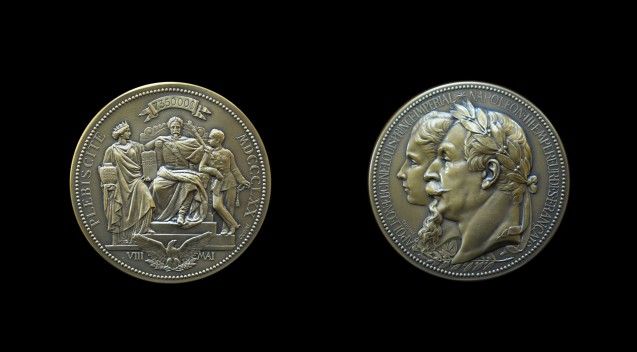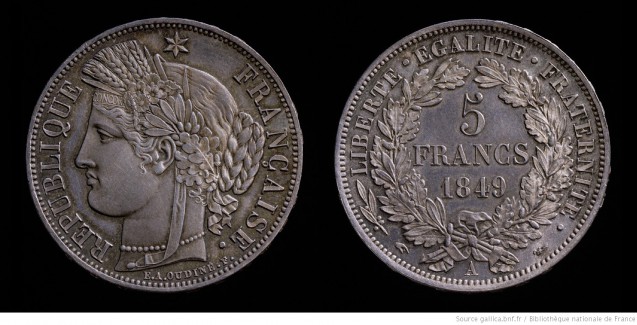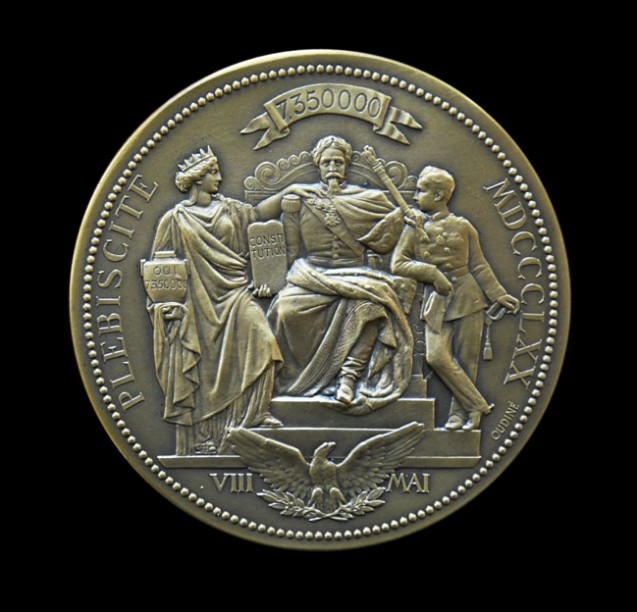The Napoleonic regime was essentially autocratic and popular, and from the Consulate period onwards, plebiscites or referenda were organised so that civil society could give its opinion on matters of constitutional law, namely:
– on the establishment of the Consulate in 1799 after the coup d’état of 18 Brumaire (plebiscite of 7 February 1800),
– on the consulate for life in 1802 (plebiscite of 2 August 1802);
– on the establishment of the hereditary Empire in 1804 (plebiscite 6 November 1804);
– on agreeing to the Additional Act to the constitutions of the Empire in 1815 (plebiscite 1 June 1815);
– on the delegation to Louis-Napoleon Bonaparte of the necessary powers for the drafting of a new constitution shortly after the coup d’état of 2 December 1851 (plebiscite of 20 and 21 December 1851);
– on the restoration of the hereditary Empire (plebiscite of 21 and 22 November 1852).
During the Second Empire, no plebiscites were organised for the next 18 years, with the exception of the plebiscites organised locally when Savoy and Nice were joined to France in April 1860.
A plebiscite on 8 May 1870 to consolidate the Empire, four months before its downfall…
Democratic Caesarism, which challenged the traditional codes of sovereignty of the monarchies based on divine right, was naturally rejected by the Monarchists, nor did it find favour with Republicans who preferred collegial power (see Patrice Pierre, notice “Plebiscite”, in Dictionnaire du Second Empire, Fayard, 1995, p. 1010-1015).
The 1860s saw a succession of international setbacks for France (in 1866, the Prussian victory over Austria at Sadowa; in 1867, the ultimate failure of the Mexican expedition, withdrawal of support for Garibaldi’s forces when it appeared that he might actually take Rome) in addition to national political and economic difficulties. The liberal laws concerning not only the press but also the right to hold non-political public meetings spurred the development of varying forms of opposition, notably Socialist, Republican and Anarchist, especially among the developing working-class population. The legislative elections of 24 May and 7 June 1869, although largely favourable to the regime (4.6 million votes), showed an increase in popular support for the Republican opposition (3.3 million votes).
It was in this context that, on 8 May 1870, the government invited the electorate to express either their approval or disapproval of imperial policy during the previous decade, with the motion: “the people approves the constitutional liberal reforms enacted in 1860 and subsequently by the Emperor, with the help of the great bodies of the State, and ratifies the sénatus-consulte of 20 April 1870”. This sénatus-consulte stated that ministers were now responsible to the Legislative Corps. More importantly, adjoined to the decree announcing the plebiscite was a manifesto by Napoleon III – who knew he was very ill – which stated: “[…] by voting yes on your ballot, you will ward off the threat of revolution, you will put freedom on a solid footing, and you will make it easier, in the future, for the crown to pass to my son” (quoted by Jean-Claude Yon, Le Second Empire, Armand Colin, 2004, p. 75).
The “yes” vote prevailed, largely due to the loyalty of the provincial electorate, with more than 7.3 million votes in favour of the motion, vs 1.5 million “no” votes.
But on 19 July, war was declared on Prussia. In less than two months, the Empire was swept away with the defeat and surrender of Napoleon III at Sedan (1-2 September) and the proclamation of the Third French Republic on 4 September.
Description of the medal
► verso: Napoleon III is sitting on his throne with, on his left, a young man leaning on the throne (clearly the Prince Imperial: Napoleon III’s left hand holding a sceptre is posed on the young man’s shoulder, in a gesture of dynastic transmission), to his right stands a woman, representing France, carrying in her left hand the tables of the Constitution, and in her right hand an urn upon which is inscribed “OUI 7350000”, around the edge is inscribed “PLEBISCITE MDCCCLXX VIII MAI”, and at the top is the number “7.350 000”. Underneath is an imperial eagle, and to the lower right the signature of Oudiné.
► Recto: the profile portrait of Napoleon III crowned by laurels is in front to the right of the portrait of Eugène (born in 1856), with the caption “NAPOLEON EUGENE LOUIS PRINCE IMPERIAL NAPOLEON III EMPEREUR DES FRANCAIS [EMPEROR OF THE FRENCH]”, and Oudiné’s signature.

Eugène-André Oudiné (1810-1887), an important engraver
Eugène-André Oudiné (1810-1887), sculptor and medal engraver, was the former pupil of the painter Jean-Auguste-Dominique Ingres and the sculptor Louis Petitot, and winner of the Grand Prix de Rome in 1837 for his engraving in medal and fine stone Œdipe expliquant l’énigme du sphinx [Oedipus explaining the enigma of the sphinx]. (see his portrait here). For more than forty years he worked for the Monnaie de Paris [the Paris Mint] and for the French Ministry of Finance.
His representation of the French Republic via the profile of Ceres (the Roman goddess of Harvest and Agriculture) is found on many French coins, including the 5 franc coin of 1849.

BnF Gallica (username ark:/12148/btv1b77004036)
Irène Delage, November 2019 (trans. RY and PH)


